Den Text, in dem ich den FC St. Pauli nach dem Sieg in Aue, dem dritten in Folge, unreflektiert abfeiere, findet ihr hier. Aber da es dort eher weniger um das Spiel geht, dieses aber viel Zeigenswertes aus Sicht des FC St. Pauli hatte, werfen wir nochmal einen Blick in die Statistik.
(Titelbild: Dostmann/imago images/via OneFootball)
Ach ja, vorher noch ein Ohrwurm, der mir seit gestern Nachmittag nicht mehr aus dem Ohr geht (Ältere unter Ihnen werden sich an die Melodie am Millerntor erinnern):
Zander! – zalazarzalazarzar – Zander!
frei nach „Thunderstruck“ von ACDC
Die Aufstellung
Keine Veränderung beim FC St. Pauli. Also auch kein Tore Reginiussen in der Startelf, wie ich im Vorbericht vermutet hatte. Der FCSP startete altbewährt in einem 4-4-2 mit Mittelfeldraute.
Bei Erzgebirge Aue gibt es hingegen einige Wechsel: Für den gesperrten Gnjatic startet etwas überraschend Philipp Riese, der zuvor nur einen Kurzeinsatz gegen Regensburg nach seinem Wadenbeinbruch hatte. Eine weitere Veränderung gab es in der Grundformation: Statt dem 3-4-1-2 stellte sich Erzgebirge Aue in einem klassischen 4-2-3-1 auf.
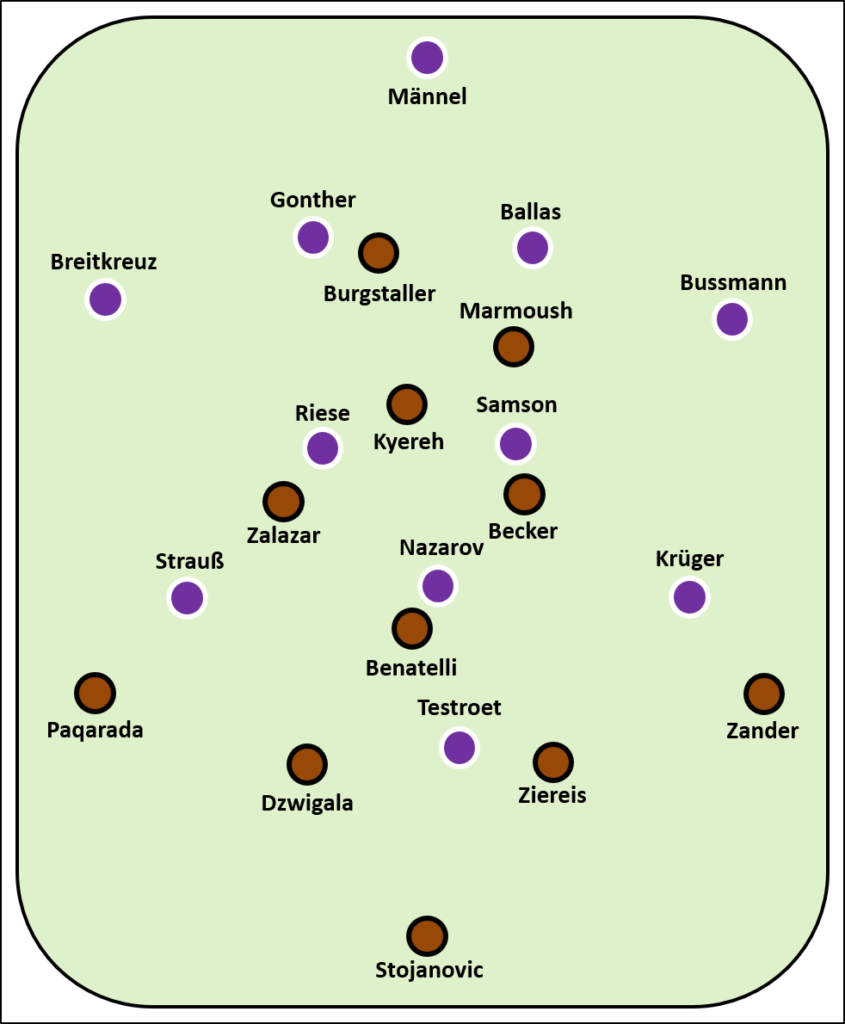
Kommt her, Saisonbestwerte!
Klar, wenn Du direkt in der ersten Minute mit 1-0 in Führung gehst, dann läuft das Spiel erst einmal ziemlich genau in deine Richtung. Was sich aber in den folgenden Minuten zeigte, war einmal mehr eine klare Feldüberlegenheit des FC St. Pauli gegen einen überforderten Gegner.
Nur im Hinspiel gegen Aue hatte der FC St. Pauli in dieser Saison mehr Ballbesitz (nämlich 63.5%) als am Samstag im Erzgebirge mit 62.7%. Es wäre wohl sogar noch deutlich mehr gewesen, wenn der FCSP nicht zum Ende jeder Halbzeit etwas den Fuß vom Gas genommen hätte. Zwischen Minute 16 und 30 lag die Ballbesitzquote zum Beispiel bei satten 82%.
Viel Ballbesitz spiegelt sich dann entsprechend auch in der Anzahl und der Quote der Pässe wieder: Zum ersten Mal in dieser Saison brachte der FCSP mehr als 500 Pässe an den eigenen Mitspieler, was einer Erfolgsquote von 85.5% entspricht (ebenfalls Saisonrekord). Einen weiteren Bestwert stellte der FCSP bei der Anzahl der Ballverluste auf: Nur knapp mehr als 100 sind ein richtig guter Wert. Aber war das auch effektiv? Knapp jeder zehnte Pass den der FCSP spielte war ein Erfolgreicher ins Angriffsdrittel und einer von drei Pässen wurde vorwärts gespielt. Die Quote setzt sich also nicht nur aus erfolgreichen Quer- und Rückpässen zusammen.
Quer- und Rückpässe wären auch relativ simpel gewesen, da Erzgebirge Aue, wie erwartet, zu Beginn nicht ansatzweise hoch presste und sich der PPDA-Wert bei 15.1 einpendelte (dank hohem Pressing am Spielende), was in etwas dem Saison-Durchschnittswert von Aue, Schlusslicht beim PPDA, entspricht. (Anm. Maik: Ja, klar, ich hab das schnell für Euch gegoogelt: PPDA = Passes Per Defensive Action, also die Anzahl an Pässen, bis es zu einer Defensivaktion kommt: Abgefangener Ball, Zweikampf, Foul. Umso höher der Wert, desto mehr Zeit gibt man dem Gegner.)
Der FC St. Pauli hingegen setzte auf ein sehr viel höheres Pressing (welches ziemlich oft erfolgreich war): Ihr PPDA-Wert lag am Spielende bei 7.7, was in der Ligaspitze zu verorten ist. Das der FCSP in der zweiten Viertelstunde des Spiels soviel Ballbesitz hatte lag übrigens auch am erfolgreichen Pressing: Zwischen Minute 16 und 30 erlaubte der FCSP dem Gegner nur knapp zwei Pässe, bevor sie mit ihrer Defensivaktion starteten. Wahnsinn!
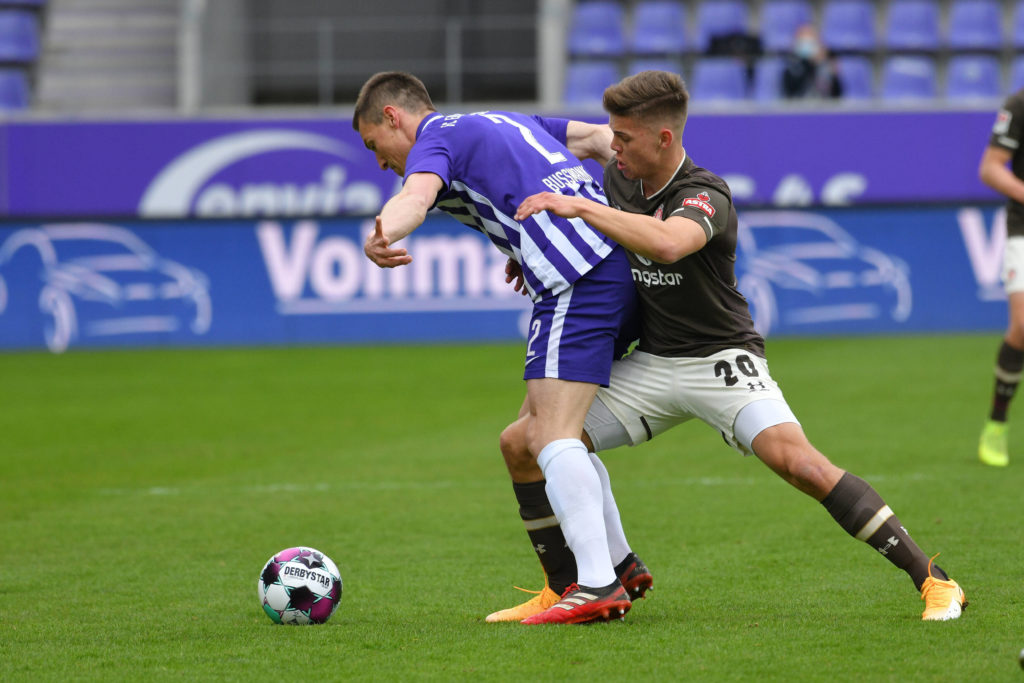
(Bert Harzer/Eibner-Pressefoto/imago images/via OneFootball)
Und aus diesem Pressing ergaben sich, wie auch gegen Braunschweig einige gute Situationen. Insgesamt acht Angriffe konnte der FCSP in Kontersituationen fahren (gegen Braunschweig waren es neun – Saisonbestwert). Bevor ich aber weiter nur Gutes berichte müssen wir festhalten, dass der FCSP nur aus zwei dieser Situationen einen Torschuss generierte, was doch verhältnismäßig wenig ist.
Allgemein drückte sich die massive Überlegenheit des FC St. Pauli nicht direkt in Form von Torschüssen aus. 15 abgefeuerte Schüsse sind eher durchschnittlich. Aber wie auch schon gegen Braunschweig ging jeder zweite dieser Schüsse auch auf das gegnerische Tor (genauer: 8 von 15), was dann wieder ein sehr guter Wert ist.
Die Überlegenheit drückt sich etwas besser im xG-Wert aus, der bei 2.29 zu 1.21 für den FCSP liegt.
Wo eine gute Teamleistung ist, da sind auch gute Einzelleistungen
Zwar nur 30 Minuten im Einsatz und beim Stand von 3-0 eingewechselt, aber, holla, was für einen Monster-Auftritt Afeez Aremu hingelegt hat! Ein einziger magerer Fehlpass, alle seine Duelle gewonnen, egal ob Dribbling, Kopfball, Defensiv- oder Offensivzweikampf. Dazu ist mir schon während des Spiels die Kinnlade runtergeklappt, als ich sah, wie er zwei Pässe von Aue abfing. This guy is really good at winning balls!
Hatte ich noch vor ein paar Tagen von einem Ungleichgewicht beim FCSP in zweierlei Hinsicht gesprochen, so wurde diese Behauptung im Spiel gegen Aue in Schutt und Asche gelegt. Spielmacher des FCSP war gestern Philipp Ziereis, ich wiederhole, Philipp Ziereis. Der hat die meisten Pässe des FCSP gespielt (79! Davon kamen 74 an.), darunter, und das muss Erwähnung finden, mehrere erfolgreiche Diagonalbälle auf die offensiven Außenbahnen und ganze drei Schnittstellenpässe. Ich hätte schwören können, dass wir das Aufbauspiel von James Lawrence vermissen werden, aber da hatte ich nicht mit passing machine Ziereis gerechnet. Richtig gut.
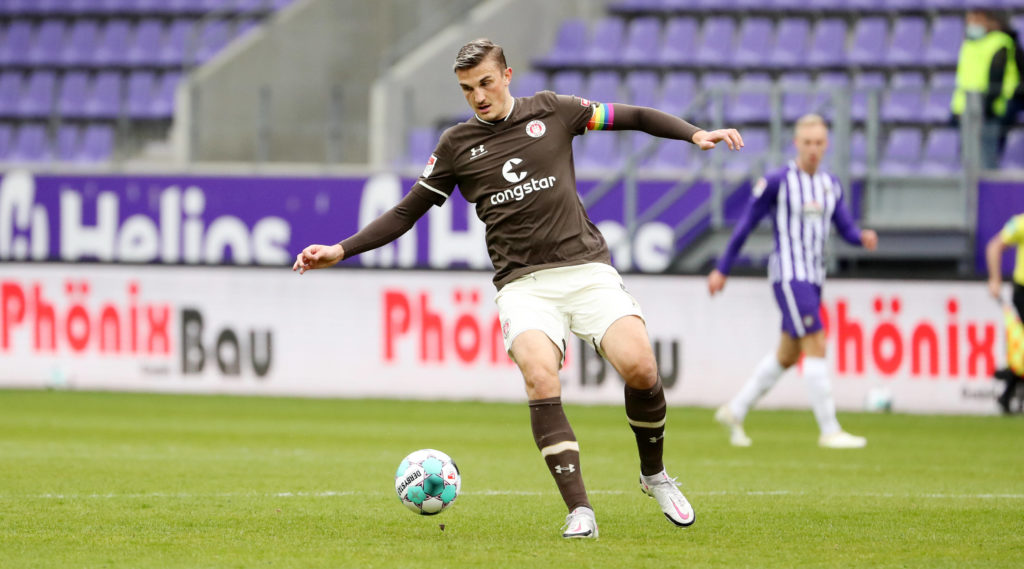
(imago images/via OneFootball),
Für das zweite Ungleichgewicht sorgten Leart Paqarada und Sebastian Ohlsson. Denn da Paqarada seine Rolle eher offensiver und mit viel mehr Ballbesitz interpretiert, war im Spiel des FCSP immer eine leichte Unwucht drin. Mit Luca Zander im Spiel gab es nicht nur von links sondern auch von rechts massiven Druck über die Außenbahn. Klar, zwei Tore sprechen für sich, aber die meine ich gar nicht (zumal es ja Standards waren). Luca Zander hat in Aue mehr Ballkontakte im gegnerischen Strafraum gehabt als Sebastian Ohlsson in seinen letzten sechs Spielen zusammen. Gleiches gilt für die Anzahl an Torschuss-Vorlagen. Zwar ist die Darstellung etwas plakativ, aber der Offensivdrang von Zander ist spürbar. Das tut dem Spiel des FCSP gut, weil der Gegner dadurch sehr viel häufiger auch über die rechte Seite des FCSP mit Positionsangriffen rechnen muss.
Ich könnte die Liste noch weiterführen: In den letzten beiden Spielen hat Adam Dźwigała nur einen einzigen Defensiv-Zweikampf verloren (auch wenn wir über das Gegentor in Aue sprechen müssen). Aber dafür, dass er vorher bis auf die wenigen Minuten in Osnabrück mal eben zwei Monate gar nicht auf dem Platz stand (und teilweise nicht im Kader) liefert er ganz schön ab.
Ich muss aber auch Omar Marmoush erwähnen. Ja klar, wieder zehn Dribblings geführt und Wahnsinn, was der für ein Tempo hat. Aber wisst ihr eigentlich, was sein größter Skill ist? Sein Passspiel. Omar Marmoush ist der Stürmer der zweiten Liga mit der besten Passquote (~83%). Natürlich muss man sich anschauen, wo er welche Pässe spielt, aber er rangiert da vor allen Offensiv-Spielern der Liga ganz oben (und wer sich seine Torvorlage gegen Braunschweig zum 2-0 anschaut, weiß auch, dass der nicht nur Rückpässe kann und spielt). Auch gegen Aue waren es wieder 12 von 13, die an den Mitspieler gingen. Das ist, besonders in den Zonen, in denen Marmoush unterwegs ist, schon echt richtig gut.
Guido B. lasse ich außen vor. Der kann so viele Dinge nicht. Zum Beispiel die Vorentscheidung erzielen.
Ich. Bin. So. Enttäuscht!
Wenn wir nun schon zwei Standardtore in einem Spiel feiern, in Aue gewinnen und so ein Spiel ohne großes Zittern am Ende austrudelt, dann kann so vieles nicht falsch gelaufen sein. Bemerkenswert, dass die Standardtore identisch, aber spiegelverkehrt waren. Zweimal läuft Zander am zweiten Pfosten einfach durch. Darf aus Sicht von Aue eigentlich schon beim ersten Mal nicht passieren, dass der so blank am zweiten Pfosten auftaucht. Aber das gleiche dann noch ein zweites Mal? Das ist ja fast vorsätzlich gewesen von Aue.
Die beiden Standardtore überpinseln dann auch so ein wenig, dass der FCSP aus dem Spiel heraus viele Chancen hatte, aber sie teils kläglichst vergab (ich sach ja, Guido kann das nicht). Besonders in der zweiten Halbzeit hätte sich Aue nicht über eine viel höhere Niederlage beschweren dürfen. Sei es drum, ich kritisiere hier schon wieder, dass der FCSP ein Spiel zwar gewonnen, aber nicht deutlich genug gewonnen hat. Da muss man auch mal nachsichtig sein (…aber nicht mit Guido!)
// Tim
(sämtliche Daten, sofern nicht anders markiert, stammen von Wyscout)
Alle Beiträge beim MillernTon sind gratis. Wir freuen uns aber sehr, wenn Du uns unterstützt.
MillernTon auf BlueSky // Mastodon // Facebook // Instagram // Threads // WhatsApp // YouTube
{:}{:en}The text in which I celebrate the win against Aue, the third in a row, a bit biased can be found here. But as this text doesn’t shed much light on the pure match itself which definitely had something to showcase from an FCSP’s perspective, let’s cast another gaze into the statistics.
But let’s start with an ear-catcher which hasn’t left my ear since yesterday afternoon (the elder ones amongst us will remember the melody from the Millerntor):
Zander! – zalazarzalazarzar – Zander!
From “Thunderstruck” of AD/DC
The line-up
No changes at the FC St. Pauli. This also meant no Tore Reginiussen in the starting eleven, which I had expected in the pre-match report. The FCSP started with its well-proven 4-4-2 with a midfield diamond.
At Erzgebirge Aue on the other side, there were quite some changes: For the suspended Gnjatic, a bit surprisingly, Philipp Riese began who just had another short appearance against Regensburg recently after his fibula fracture. Another change happened in the basic formation: Instead of the 3-4-1-2, Erzgebirge Aue lined up in a classical 4-2-3-1.

Come here, best values of the season!
Of course, if you take the lead in the very first minute, the match clearly runs in your direction. But what followed in the following minutes was clear supremacy of the FC St. Pauli on the pitch against an overwhelmed opponent.
Only in the match of the first leg against Aue the FC St. Pauli had more ball possession (namely 63.5%) than in the match on Saturday in the Erzgebirge with 62.7%. It would have been even more than that if the FCSP didn’t decide to take the foot off the throttle at the end of both halves. Between the 16th and the 30th minute, the ball possession rate was at a saturated 82%.
A lot of ball possession is also reflected in the number and rate of passes played: For the first time of the season, the FCSP delivered more than 500 passes to the own teammates which equals a success rate of 85.5% (also a new high of the season). Another best value was reached with regards to lost balls: with only a little over 100, this is a very good value. But was it effective though? Nearly every tenth pass the FCSP played was a successful one into the last third and one of every three passes played was played to the fore. So this value isn’t only based on successful horizontal or back passes.
Horizontal and back passes would have been fairly easy though, as Erzgebirge Aue, as expected, didn’t press high at all when the match started with an average PPDA-value leveling off at 15.1 (due to a high pressing at the end of the match, which is almost in line with the season’s average-value of Aue, that holds the red lantern in terms of PPDA (Note of Maik: Of course, I quickly googled PPDA for you= Passes Per Defensive Action which is the number of passes that are played before a defensive action is initiated: a caught pass, a duel, a foul. The higher the value, the more time is given to the opponent in this regard). On the other side, the FC St. Pauli aimed for a much higher pressing (which was successful pretty often): its PPDA-value when the match ended was 7.7 on average which is to be located amongst the top teams of the division. And it was due to the successful pressing that the FCSP had that much ball possession in the second fifteen minutes of the match: between minute 16 and 30, the FCSP only allowed two passes of the opponent before they started with their defending! Marvelous!

(Bert Harzer/Eibner-Pressefoto/imago images/via OneFootball)
And from this pressing, alike against Braunschweig, some good situations emerged. In total eight successful attacks could be initiated by the FCSP out of such transition moments (against Braunschweig there were nine similar situations, the best value of the season). But before I only report the good stuff only we also have to acknowledge that the FCSP only managed to shoot at the goal in two of these eight situations which is a rather poor outcome.
In general, the massive supremacy of the FC St. Pauli isn’t directly reflected by shots. 15 shots are rather average. But alike against Braunschweig every second shot was a shot on target (to be precise: 8 of 15) which is a good value though.
The supremacy is a little better reflected by the xG-value which was 2.29 to 1.21 for the FCSP.
When there’s a good team performance, there’s also some good individual one
Although he played for 30 minutes only and was only substituted when the score was 3-0 already, holy cow what a performance of Afeez Aremu! Only one meager bad pass, won all of his duels, no matter if dribbling, header, defensive or offensive duel. Already during the match, I couldn’t believe what I saw when he caught two passes of Aue. This guy is really good at winning balls!
A few days ago, I wrote about an imbalance at the FCSP in two regards but this claim was absolutely destroyed in the match against Aue. The playmaker of the FCSP yesterday was Philipp Ziereis, I have to repeat: Philipp Ziereis. He played most of the passes of the FCSP (79 of which 74 were successful) and amongst those passes that need to be highlighted were some successful diagonal passes to the offensive outer flanks and three such passes through the centre. I would have been almost certain that we would dearly miss the build-up play of James Lawrence but I hadn’t taken the passing machine Ziereis into account yet. Really strong.

(imago images/via OneFootball),
The second imbalance was caused by Leart Paqarada and Sebastian Ohlsson. As Paqarada is usually playing more offensive and with more ball possession than Ohlsson, the play of the FCSP was slightly imbalanced. With Luca Zander as a right wing-back, there was not just massive pressure on the left flank but also on the right. Of course, two goals speak a clear language but I am not referring to those (as they were rather set-pieces). In Aue, Luca Zander had more ball contacts inside the opponent’s box than Sebastian Ohlsson throughout his last six matches on the pitch. The same is true for the number of goal-assist attempts. Well, this report appears quite bold but the offensive desire of Zander is clearly recognisable. And this contributes well to the play of the FCSP as their opponent now also has to expect positional attacks from the right flanks much more often.
I could widen this list with plenty more players: During the last two matches, Adam Dźwigała only lost one defensive duel (even though we have to talk about the goal of Aue). But taken into account that this lad wasn’t on the pitch (or even in the squad) for almost two months (if we let the few minutes in Osnabrück aside), he’s delivering quite well.
And I also have to point at Omar Marmoush. Yes, led ten dribblings again and his speed is absolutely incredible. But do you know his biggest skill? When he’s passing. Omar Marmoush is the best forward of the second division in terms of playing passes with a pass ratio of ~83%. Of course, we have to look where he plays which pass but he’s definitely top notch of all forwards of the division (and if you look at his assist for the 2-0 against Braunschweig you know that he can play more than just back passes). And also against Aue, he delivered 12 of 13 passes to his teammates. Especially with regards to the spaces Marmoush is covering on the pitch, this is a really good value.
I don’t mention Guido B. He isn’t capable of many things. For example scoring the pre-decision. I. Am. So. Disappointed!
If we celebrate two goals after set-pieces in one game only, in Aue, and when a match isn’t thrilling until the end, there’s isn’t much that has gone wrong. It’s remarkable that the goals after set-pieces were almost identical, even though mirrored. Two times, Zander simply runs towards the back-post. From Aue’s perspective, it mustn’t have happened that Zander appears at the back-post at the first time. But the same all over again? This appeared almost intended by Aue. The two goals after set-pieces also cover up a little bit that the FCSP had many chances out of their play but didn’t manage to score in so many facets. (I told you already, Guido isn’t capable to do so). Especially during the second half, Aue shouldn’t have mourned about a higher defeat. Anyway, I am again starting to blame the FCSP for winning a match not high enough. We should rather indulge here (..but not with Guido!).
//Tim (translated by Arne)
(all data, if not cited differently, by Wyscout)
MillernTon Twitter //
MillernTon YouTube //
MillernTon Facebook //MillernTon Instagram //
If you like what we do here, here you’ll find the information on how to support us.
{:}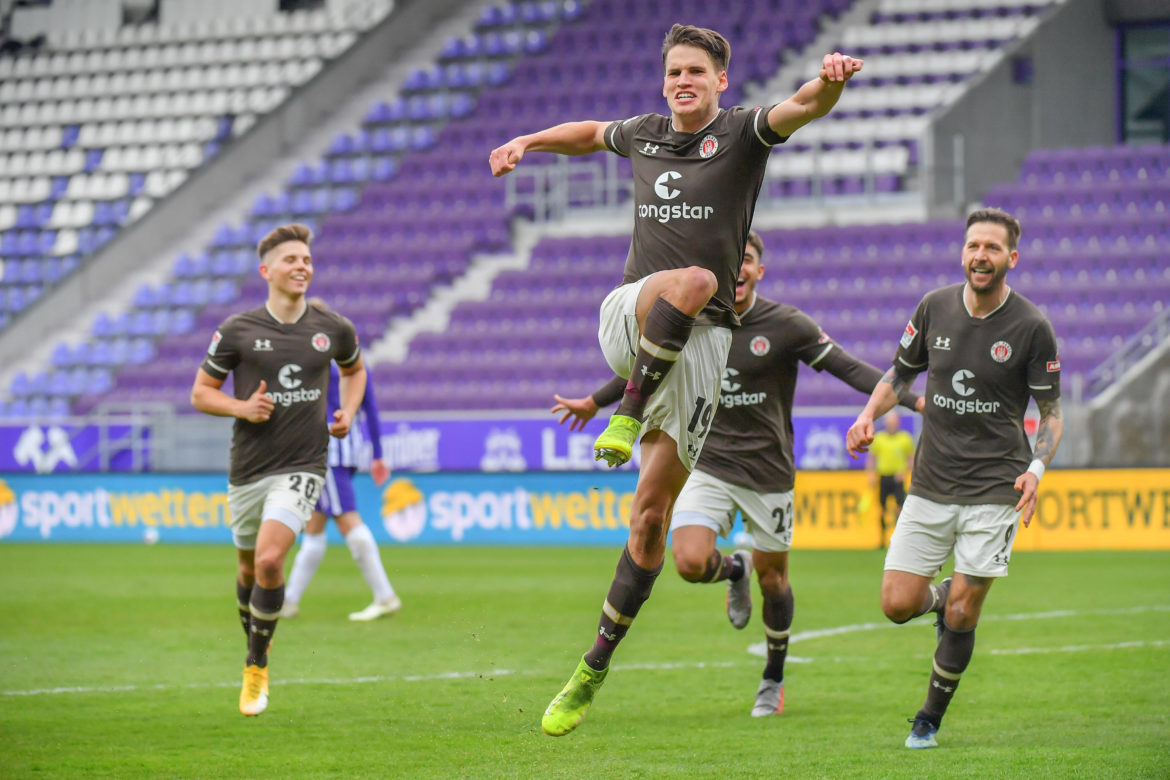


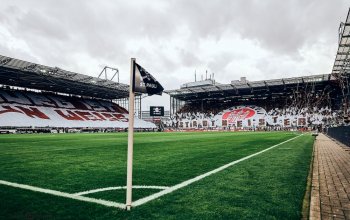

MoinMoin,
ich hatte mich gefreut, das Dittgen und Daschner dieses Mal recht früh eingewechselt wurden. Ein bisschen mehr Zeit als sonst sich zu empfehlen. Das ist ihnen fand ich leider nicht so gut gelungen. Schade…
Aber wie, du sagst Tim, schön sich darüber zu ärgern, dass man „nur“ 3:1 gewonnen hat. Was für ein Luxus 🙂
Ja, ich hatte auch gedacht, dass die beiden etwas mehr Eigenwerbung betreiben. So ist mir aber vor allem Aremu in Erinnerung geblieben. Trotzdem bin ich fast sicher, dass Lukas Daschner noch ein ganz wichtiger Bestandteil des FCSP-Spiels werden wird.
Moin Tim,
wie immer eine sehr coole Analyse.
Schon der Hammer, wie sich das Team entwickelt hat.
Grosses Kompliment an Schulle, Loic und Fabian!
Auch an die Vereinsfuehrung und Bornemann fuer den Mut in der Krise zum Trainerteam zu stehen–womit wir wohl endlich auch den hire-und-fire Teufelskreis durchbrochen haben, der sich bei uns eingeschlichen hatte.
Was mich interessieren wuerde:
Wie glaubst Du hat das Trainerteam es geschafft, diese Form von Spielkultur zu entwickeln–und werden wir das auch naechstes Jahr (evtl mit neuen Spielern in der Offensive) wiederholen koennen?
Bin ein grosser Fan Deiner Texte–daher eine kleine Anmerkung zum Schluss. Ich verstehe ja dass Du Guido „positiv jinxen“ willst–aber Kontext ist alles. Ein Leser (z.B. ein Spieler), der dich nicht regelmaessig liesst, koennte das in den falschen Hals bekommen, zumal Guido zur Zeit etwas Ladehemmung zu haben scheint…
Forza Aufstieg 2022!
Zet
Das Trainerteam hat ja auch in der Hinrunde einiges ausprobiert. Rückblickend betrachtet war noch deutlich zu merken, dass sich alle nach dem Umrbcuh im Sommer erst einmal finden mussten. Und natürlich: Wenn das Duo Marmoush/Burgstaller auch in der Hinrunde gemeinsam auf dem Platz gestanden hätte, dann wäre sicher noch viel mehr drin gewesen. Andererseits bracuhte das Team dieses Tief womöglich auhc, damit sie nun gestärkt daraus hervorgehen konnten.
Das mit dem flaschen Hals habe ich auch schon überlegt. Allerdings ist der Vorwurf an Guido, das er nichts könne, einfach so dermaßen agwegig, dass da jemand schon wirklich wenig Ahnung von Fußball etc haben muss, um diesen Vorwurf ernst zu nehmen. Aber ich werde auf so etwas ein wenig mehr achten. Danke für den Hinweis.
Ja, macht Sinn. Der Oberhammer waere eine gemeinsame Nachbetrachtung im Millernton mit Schulle oder Loic. (Loic trainiert so weit ich weiss, die defensiven Ecken.) 🙂
Das Problem mit Humor ist, dass er international oft nicht funktioniert oder ganz anders rueberkommen kann. Und wir haben internationale Spieler und eine internationale Fanszene. Bin selbst international unterwegs und musste ich selbst schon erleben…
Forza FCSP, forza Millernton
Habe den Text auch mit großer Spannung gelesen (und nun eben übersetzt 😉 ) und dabei sind mir in Bezug auf die hohen Werte des Ballbesitzes die Ausführungen des VdS-Gesprächspartners von Bobby ins Gedächtnis gekommen, der darauf hinwies, dass Aue den Ball gerne den Gegnern überlasse, um ihm dann im Mittelfeldpressing wieder abzunehmen und „wilde Maus“ in Richtung Tor zu spielen. Über Aues diesbezügliche Leistung am Samstag brauchen wir hier nicht wirklich reden, aber kann der hohe Wert gerade zu Beginn des Spieles, nicht auch aus der taktischen Anweisung Dirk Schusters zu eben diesem Verhalten resultieren und wäre dann gar nicht mehr eine so große Leistung des FC St. Paulis?